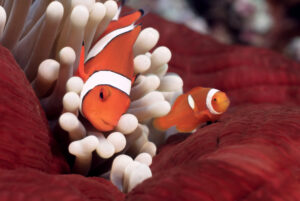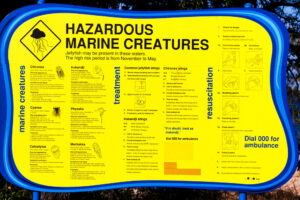When you hear the word, Great Barrier Reef, that conjures up images of vibrant corals, crystal-clear waters, and an astounding variety of marine life. For snorkelers and divers, this natural wonderland offers a front-row seat to an underwater extravaganza, with some of the most enchanting fish species in the world.
In this blog post, you’ll be wanting to grab your snorkel mask and fins and book a trip, because we’re about to dive into the top species of fish in the Great Barrier Reef!

Dive into Diversity
Imagine a place where over 1,500 species of fish coexist in a dazzling display of colours and behaviours. That place is the Great Barrier Reef. This UNESCO World Heritage site is not only the largest coral reef ecosystem in Australia but also a hotspot for marine biodiversity. Its warm, turquoise waters provide a haven for an astonishing variety of fish, making each snorkelling or diving expedition a unique adventure.
The Great Barrier Reef, a marine paradise spanning over 2,300 kilometres, is home to a mesmerising array of fish species. From the vibrant Coral Trout to the enigmatic Hammerhead Sharks, the reef’s waters teem with life, offering a glimpse into the astonishing diversity of marine ecosystems. Let’s dive into the depths and explore some of the remarkable fish species that grace the Great Barrier Reef.
A Kaleidoscope of Colors and Behavior
One of the reef’s most enchanting inhabitants is the Coral Trout. With its striking hues that range from deep reds to electric blues, this fish is a true marvel to behold. Their intricate patterns serve not only to captivate our eyes but also to aid in camouflage and communication. Coral Trout are skilled predators, often lurking near coral formations to ambush their prey. These carnivorous creatures play a vital role in maintaining the delicate balance of the reef ecosystem.
The Speed Demons of the Reef
Zooming through the waters with unparalleled speed, Spanish Mackerel are the true speedsters of the reef. With streamlined bodies and a metallic blue-green hue, they are a sight to behold as they chase down their prey. These predatory fish have a vital role in controlling the population of smaller fish, contributing to the overall health and balance of the reef’s marine life.
Majestic and Mysterious Habitants
In the deeper waters of the Great Barrier Reef, the iconic silhouette of the Hammerhead Shark glides through the depths. Known for their unique, hammer-shaped heads, these creatures are apex predators, commanding respect as they navigate their ocean domain. While sightings of Hammerhead Sharks can be exhilarating for divers, it’s important to remember that they are part of a delicate ecosystem and deserve protection.
Threatened Populations
Despite the awe-inspiring beauty and diversity of the Great Barrier Reef, some fish populations face threats to their survival. Among these are the populations near Lizard Island and Heron Island. These delicate ecosystems have been subjected to environmental changes and human impact, underscoring the urgent need for conservation efforts to protect and restore these vital habitats.
Top Species of Fish in the Great Barrier Reef to See While Snorkeling and Diving
Exploring the Great Barrier Reef is a journey into a world of wonder, where colours dance and marine life thrives. Each species contributes to the symphony of life that makes the reef a treasure trove of biodiversity.
Clownfish
These tiny, vibrant fish are famous for their starring role in the movie “Finding Nemo.” Found darting in and out of sea anemones, they have a fascinating symbiotic relationship with their hosts, where both parties benefit.
Parrotfish
Sporting a beak-like mouth and a vivid colour palette, parrotfish are like the painters of the reef. They munch on coral, helping to keep it healthy, and as a bonus, excrete fine sand – contributing to the formation of sandy beaches.
Butterflyfish
With their striking patterns resembling a painter’s canvas, butterflyfish are a sight to behold. They flit around coral reefs, feeding on coral polyps and algae, playing a vital role in maintaining the reef’s delicate balance.
Surgeonfish
Recognizable by their bright colours and distinctive scalpel-like tail spines, surgeonfish have an important job – they’re the cleaners of the reef. Feasting on algae, they prevent it from smothering the corals.
Maori Wrasse
The Maori wrasse is a showstopper with its large size and stunning blue-green hues. Friendly and curious, they might even swim alongside divers, creating unforgettable memories.
Reef Sharks
Don’t let the word “shark” scare you. The reef is home to various species of reef fish and sharks, including the docile white-tip reef shark. Observing these magnificent creatures from a safe distance can be a thrilling experience.
Diving Responsibly and With Care
Exploring the stunning underwater world through snorkelling and diving is an unforgettable experience, especially in places like the Great Barrier Reef. As excited as we are about these underwater wonders, it’s crucial to approach the reef with care and respect.
To preserve this delicate ecosystem for future generations, remember to follow responsible snorkelling and diving practices. Avoid touching or disturbing marine life, refrain from standing on coral, and use reef-safe sunscreens to protect both yourself and the environment.
For nature lovers and adventure seekers, we must ensure that we leave behind nothing but memories and preserve the delicate marine ecosystems. Here are some more essential tips for responsible snorkelling and diving:
- Respect Marine Life and Habitat
- Choose Reef-Friendly Sunscreen
- Don’t Collect Souvenirs
- Secure Your Equipment
- Follow Guided Tours
- Minimise Contact
- Pack Out What You Pack In
- Learn About Marine Life
- Avoid Feeding Marine Life
- Capture Memories Responsibly
- Support Conservation Efforts
- Spread Awareness
Where to Dive In
The Great Barrier Reef spans over 2,300 kilometres, offering numerous diving and snorkelling sites. From the iconic Ribbon Reefs in the north to the vibrant coral gardens of the southern region, each spot promises a unique encounter with the reef’s residents.
Before you embark on your underwater adventure, ensure you have the right gear. A well-fitting snorkel mask, comfortable fins, and a wetsuit if necessary will enhance your experience. Familiarise yourself with basic diving etiquette and safety measures to make the most of your time underwater.
Book Your Trip to the Great Barrier Reef
The Great Barrier Reef is a symphony of colours, shapes, and behaviours that beckons adventurers to explore its depths. With an array of fish species as diverse as the coral itself, every snorkelling or diving session offers a chance to witness the magic of the ocean.
Being responsible for snorkelling and following diving tips, you can enjoy the breathtaking beauty of the underwater world while actively contributing to the preservation of these fragile ecosystems. Remember, we are all custodians of the ocean, and our actions today shape the future of these extraordinary environments.
Planning to go to see all the species of fish in the Great Barrier Reef? Gear up, dive in, and let the marine marvels of the reef leave you awe-inspired and committed to its preservation. May it be a day trip or overnight, book with us today!


